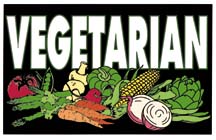Lives
tock
Eat Better Than Many of the World's
Poor
Livestock eat the grain and soybeans that
could feed the hungry. In so doing, they
inefficiently
convert agricultural products to a very small amount
of
beef.
- Numer of human beings who could be fed
annually by the grain and soybeans eaten by U.S.
livestock: 1,300,000,000
- Number of people who
will starve to death this year:
60,000,000
- Number of people who could be
adequateley fed by the grain saved if Americans
reduced their intake of meat by 10 percent:
60,000,000
- Pounds of grain and soybeans needed
to produce one pound of feedlot beef:
16
- Number
of pure vegetarians who can be fed on the same amount
of land needed to feed one meet eating person:
20
- Percentage of protein wasted by cycling
grain
though livestock: 99
- Percentage of
carbohydrate
wasted by cycling grain through livestock: 90
- Percentage of dietary fiber wasted by cycling
grain
though livestock:
100
- Pounds of potatoes that can be grown on 1
acre of land: 20,000. Pounds of beef that can be
produced on 1 acre of land: 165.

Animal
Rights
Eating meat, of course, involves
killing
animals. A single visit to a slaughterhouse has been
enough to convert many to vegetarianism.
- Reason
veal is so tender: Calves are never allowed to take a
single step.
- Reason veal is whitish pink:
Calves are force-fed an anemia-producing
diet.
- The McDonald's clown, Ronald McDonald,
tells children: "Hamburgers grow in hamburger patches
and love to be eaten." Ronald McDonald doesn't tell
children: "Hamburgers are ground up cows who've had
their thoats slit by machetes or their brains bashed
in by
sledgehammers."
- Number of amimals killed for
meat per hour in the United States:
500,000
- Occupation with the highest employee
turn over rate in the United States: slaughterhouse
worker
- Occupation with the highest rate of
injury in the United States: slaughterhouse
worker
- Cost to render an amimal unconscious
prior to slaughter so that process is done humanely:
1
cent. Reason given by meat industry for not utiliving
captive bolt pistol: too expensive.
Even if we
have
no qualms about the slaughter of animals for food
there are
serious enviromental and other ethical issues
involved.
The grazing of cattle, sheep, and goats
for meat can have a valid place in an ecologically
balanced food economy. For one thing,not all land is
fit for the cultivation of food crops such as grains
and beans; the soil may be poor and there may be
inadequate water.
However,the number of animals
raised exclusively on rangelands in America is small.
Most spend a good part of their lives in feedlots.
These are enclosed areas where thousands of animals
ae
croweded together and fattened with a diet of corn,
soybean, and other potential human foods. These
feedlots amount to animal concentration camps. Life
in
the feedots is so unhealthy that the animal are
constantly dosed with antibiotics, which poses health
risks for humans.
- Percentage of antibiotics
produced
in this country used for livestock feeds: 55
The
animals
produce manure--literally mointains of it, which if
properly treated might be used as fertilizer or even
as a
source of methane fuel. Unfortunately, it usually is
treated as a waste product. It is allowed to wash
away
into streams, rivers,and lakes, where its high
concentrations of nitrates and phoshates upset the
natural
ecology. The Chsapeake Bay, for example, long a
major
source of fish and shellfish has become almost barren
due
to amimal-waste runnoff from farms along its source
rivers.
- Production of excrement by total U.S.
human
population: 12,000 pounds per second. Production of
excrement by U.S. livestock: 250,000 punds per
second.
- Percentage of harmful organic
waste-water
pollution attributable to U.S. human population:10.
Percentage of harmful organic waste-water polluion
attributable to U.S. livestock: 90

Wasted
Water
Not only are vast amounts of water
polluted by
livestock--but even larger amounts are consumed in
the
breeding process
- Enough water goes into the
feeding
and care of the average cow to: float a
destroyer.
- Water needed to produce a pound of
meat:
2,500 gallons

Protecting Our
Forests
If we eat beef, especially the cheaper
varieties used in fast food outlets, there is another
fact
to consider. A substantial amount of this beef comes
from
Central American countries where the cattle industry
has
been involved in the wholesale destruction of the
tropical
rainforests. Huge tracts of forest are cleared by
bulldozers and are sown with grasses for grazing.
Cattle
are pastured in these areas and the meat sold at low
prices
to American companies. In a few years the fragile
topsoil
becomes depleted and the area is abandoned. The
bands of
massive rain forests that gring the equator is a key
factor
in the ecology and climate of the earth. It is being
devestated in the noble cause of cheap hamburger. A
similar problem exists in the United
States.
- Number
of acres of U.S. forest that have been cleared to
create
cropland to produce a meat-centered
diet:260,000,000
- How ofter an acre of trees
disappears in this country: every 5
seconds
- Atthe
present rate of deforestation, number of years before
not a
singl tree will remain standing in the United States:
50
- Amount of trees spared by each individual
who
swiches to a pure vegetarian diet: 1 acre

Protecting Our
Own
Lives
Lastly, we all have our own health, and
that
of our friends and family to consider.
- Increased risk of breast cancer for
women
who eat meat daily compared to women who eat meat
less than
once a week: 4 times higher
- Leading sorce of
pesticide residues in the U.S.diet: meat--55 percent.
Total
pesticide residues in U.S. diet supplied by
vegetables: 6
percent. Total pesticide residues in U.S. diet
supplied by
fruits: 4 percent. Total pesticide residues in
U.S.diet
supplied by grains: 1 percent











 home
home